Based on the data and code below, how can I change of the legend items such that the legend item Males is under the Male portion of the pyramid plot and vice versa?
I tried:
# Change the order of values to reflect them in the plot
pop_hisp_df$Type = factor(pop_hisp_df$Type, levels = rev(pop_hisp_df$Type))
Error in `levels<-`(`*tmp*`, value = as.character(levels)) :
factor level [2] is duplicated
Current Output:
Data (pop_hisp_df):
structure(list(age_group = c("< 5 years", "5 - 14", "15 - 24",
"25 - 34", "35 - 44", "45 - 54", "55 - 64", "65 - 74",
"75 - 84", "85 +", "< 5 years", "5 - 14", "15 - 24", "25 - 34",
"35 - 44", "45 - 54", "55 - 64", "65 - 74", "75 - 84",
"85 +"), Type = c("Males", "Males", "Males", "Males", "Males",
"Males", "Males", "Males", "Males", "Males", "Females", "Females",
"Females", "Females", "Females", "Females", "Females", "Females",
"Females", "Females"), Value = c(-6, -13, -13, -15, -17, -15,
-11, -6, -3, -1, 6, 12, 12, 14, 16, 15, 12, 7, 4, 2)), row.names = c(NA,
-20L), class = c("tbl_df", "tbl", "data.frame"))
Code:
library(tidyverse)
library(plotly)
# Plot
gg_pop_hisp = ggplot(pop_hisp_df, aes( x = forcats::as_factor(age_group), y = Value, fill = Type)) +
geom_bar(data = subset(pop_hisp_df, Type == "Females"), stat = "identity") +
geom_bar(data = subset(pop_hisp_df, Type == "Males"), stat = "identity") +
#geom_text(aes(label = paste0(abs(Value), "%"))) +
scale_y_continuous(limits=c(-20,20),
breaks=c(-15,-10,0,10,15),
labels=paste0(c(15,10,0,10,15),"%")) + # CHANGE
scale_fill_manual(name = "", values = c("Females"="#FC921F", "Males"="#149ECE"), labels = c("Females", "Males")) +
ggtitle("HISPANIC POPULATION BY GENDER AND AGE GROUP") +
labs(x = "AGE GROUPS", y = "PERCENTAGE POPULATION", fill = "Gender") +
theme_minimal() +
theme(legend.position="bottom") +
coord_flip()
# Interactive
ggplotly(gg_pop_hisp) %>%
layout(
legend = list(
orientation = 'h', x = 0.3, y = -0.3,
title = list(text = '')))



